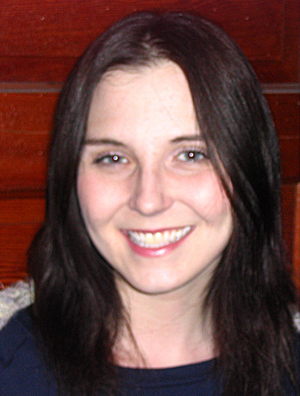Ready to learn more?
Get all the details straight to your inbox!

To enrol as a Luther College student, simply fill out the University of Regina application form and select Luther as your campus of choice.

Smaller class sizes at Luther College means more individualized attention and better connections with your professors, classmates, and academic advisors.

Luther students can register in Arts, Science, or Media, Art, and Performance. Luther students are U of R students and receive a U of R degree.

Every degree program at Luther College offers a study abroad option and an optional experiential learning component where you gain real world experience and get paid while going to school!

Luther College is a great choice for high school to university transition. Enjoy all the benefits of a larger campus, without feeling lost in the crowd. Our community is full of caring mentors and peers to ensure a positive student experience.

Free enrolment counselling support and invaluable one-on-one academic advising are available for all programs at Luther College.

You can book a tour of Luther College, the U of R campus, and our student residence, The Student Village at Luther College, any time throughout the year. Contact our Recruitment Office at 1-306-206-2117.

Eating better means studying better. The Luther Cafeteria offers fresh, healthy, nutritious meals seven days a week with a self-serve “all-you-care-to-eat” concept students prefer.
Get all the details straight to your inbox!
One of the most remarkable episodes to come out of the European witch craze was the panic that gripped East Anglia, England from 1645-1647. This period saw more executions for witchcraft than any other chapter in the history of that nation and part of the reason was the sudden appearance on the scene of a gentleman named Matthew Hopkins. Working under the title “witchfinder general” Hopkins (along with his partner John Stearne) travelled through the countryside with the intention of bringing witches to justice. Though common on the continent, Hopkins was England’s first and only official witchfinder, and his appearance was often the catalyst needed to turn public fear into action.
Hopkins’ rise to fame came at a time when England was going through one of its darkest periods to date. Economic depression, religious rivalries, and the ever-present threat of civil war left the population wary and uncertain. These factors combined to form a new climate where superstition and paranoia were slowly gripping the citizens in the countryside, making Hopkins’ arrival all the more fortuitous. Though Hopkins has often been blamed with instigating the panic, he did not do it alone. A combination of factors was responsible for this needless suffering and death, and Hopkins simply acted in accordance with public demand. Moreover, as this paper will illustrate, Hopkins’ efforts were the culmination of many decades of increasing fears of witchcraft in England.
The first English legislation specifically designed to address the issue of witchcraft did not occur until 1542 with a bill introduced by King Henry VIII.[1]The bill, appropriately named the “Bill against Conjuration and Witchcrafts and Sorcery and Enchantments” highlights the new attention being given to the threat of witchcraft in England. Unlike similar laws on the continent, the bill itself makes no mention of a pact with the devil as a feature important to identifying a witch. Rather, the bill seeks to outline the host of various activities (using waxen images, divination with precious metals, etc.) considered “witchcraft” by the law. Like the laws before it, the 1542 statute was not considered a real threat to the general populace. In fact, historical records note only one case in which the statute was applied (against a woman who was eventually pardoned).[2] The statute was overturned in 1547 as the King sought to overhaul the legal code in order to better address other statutes concerning both treason and felony. As a result, there were no laws against witchcraft on the books in England between the years 1547 and 1563.[3]
Queen Elizabeth, who succeeded her father in 1558, was (like many early modern monarchs) superstitious. She was particularly terrified of anyone using horoscopes or astrology to prognosticate her future. In 1563, she enacted a new statute against witchcraft and for the first time in history the Devil was linked with English law.[4] Indeed, the first major witch trial in England took place at Chelmsford in 1566, only three years after Elizabeth’s statute. This trial, following on the heels of the new laws, set the stage for most major witchcraft trials throughout England. The trial saw three defendants charged with acts of maleficium ranging from harming infants to tampering with livestock. Though all the accused eventually confessed, their punishments were relatively light, each receiving a year in prison.[5]
The Chelmsford trial was important in that it highlighted both the use of familiars and the presence of so-called “witch’s marks.” Despite the mention of these marks, there was still no mention made of either the pacts with the devil or secret Sabbath meetings that featured so prominently in continental trials.[6] Another unique feature of the Chelmsford trial was its establishment of the acceptance of child testimony. Under normal circumstances, English law placed the minimum age of a witness at fourteen years. Because of the magical nature of witchcraft however, it was considered to be a crimum exceptum (exceptional crime) and normal rules regarding child’s testimony were disregarded.[7]
When James I had ascended the throne in 1603, he was a fierce opponent of witchcraft. As former child king of Scotland, James was raised amidst constant fears (both real and imagined) of conspiracies against his life. Some of these threats even hinted at witchcraft specifically. This was the case when a secret society was discovered whose members were practicing magic with the direct aim of dethroning their King.[8] James also felt that witchcraft was the cause of a storm that prevented him meeting with his future bride, leaving him stranded in Denmark. In an effort to address these concerns, he published his Demonology in 1597.[9]
Demonology was a treatise against the work of the devil, and in it James stresses the importance of being able to identify and catch any witches that may be threatening an area. James made his feelings towards witches apparent with his advocacy of both torture and execution for suspected witches. Seeking to make his convictions law, James enacted his statute of 1604 against the practice of witchcraft.[10] With help from Lord Chief Justice Sir Edmund Anderson (who was himself an ardent crusader against witches), King James was able to more directly connect witchcraft with an actual pact with the devil. This statute served to place English law more in line with continental beliefs and though similar to Elizabeth’s statute of 1563, the punishments prescribed were much more severe. Now, activities associated with witchcraft (“invocation, conjuration, or employment of any wicked spirit”), were punishable by hanging instead of imprisonment.[11] This new statute represented a reflection of some of the new attitudes emerging regarding of witchcraft, its rise, and the threat it was posing to society.
At this juncture, it is important to highlight the differences between so called “witch trials” and “witch panics” experienced throughout Europe at this time. Though seen as superstitious and unjust to the modern eye, most people accused of witchcraft were at least granted some semblance of a trial (with varying degrees of success). The trials, conducted by either church or court magistrates followed some set of general rules regarding areas like testimony, jury selection, and punishment. Though trials varied by region, most areas at least followed some semblance of this sort of “due process.”Witch panics however, were a much more random and terrifying phenomenon. Usually sparked by an initial accusation, these incidents would often spiral out of control quickly.[12] Soon the panic of the masses would spread rumours that would engulf entire families, neighbourhoods and provinces with the fear of the unholy. Attempting to preside over the populace during these moments of panic were judges and magistrates both as fearful and superstitious as the townsfolk they were charged with controlling.[13]
One of these early panics took place in 1582 in the village of St. Osyth when thirteen women were put on trial.[14] The accusations were largely based on the testimony of children as little material evidence existed against the accused. Spectral evidence (invisible/ghostly moving about) was also considered during this trial, meaning that the suspect need not have even been in the room to be blamed for a crime. Though children’s testimony and spectral evidence would never have been seriously considered prior to the witch craze, most magistrates were inclined to look upon cases involving witchcraft differently.[15] The supernatural natures of the crimes meant that unorthodox measures had to be taken to counteract them, and that included accepting the previously unacceptable.
One horrifying example of how this sort of testimony could spark outbreaks of panic took place several years later, during the Warboys panic of 1589. The episode began when ten year old Jane Throckmorton blamed fits she was having on a spell cast by fellow villager, seventy six year old Alice Samuel.[16]Soon, Throckmorton’s siblings and some of their household staff began experiencing fits similar to those of Jane. Along with these accusations, Samuel was also charged with causing the death of Lady Cromwell (who was actively campaigning to stop the “witch” at the time of her death). By the time the trial came to an end in 1593, Samuel, her husband John and their daughter Agnes were hanged for the murder [17] The trial and execution of the Samuel family highlights the consequences of the new acceptance of both supernatural evidence and children’s testimony.
These new standards considering the supernatural required new experts, well- versed in combating the satanic arts and best able to prevent the spread of the evils of witchcraft. These experts came to be known as “witch hunters”, and they could often be found at the centre of these localized panics. Taking charge in areas where judicial authority was weak and religious zeal was strong, these men claimed to be able to identify, isolate and quell any witches within a community.[18]
On the continent, Claudius Musiel was one of these early witch hunters. His “Witch Register”, published in 1586, was purported to include the names of all the witches in Europe.[19] Another noted witch hunter was Austrian physician Aadam Lebaldt of Lebenwaldt (1624-1696). Like Musiel, he also contributed considerable time towards stopping the spread of witchcraft.[20] He authored several tracts speaking out against witches, encouraging readers to actively seek them out and stop them.
The first of the English witch hunters was a man named John Darrel. In 1586, Darrel, a Puritan minister vowed to “expose all the witches in England”.[21] His efforts resulted in witch trials held in Derbyshire, Lancashire and Nottinghamshire. Despite this early success, Darrel was greatly discredited when his involvement with fake exorcisms came to light. Nonetheless, his ability to instigate trials highlights the ease with which possible panics could spread. These witch hunters inspired countless others and eventually a sense of collective vigilantism began to pervade many areas throughout Europe.
From 1642-1651, a series of armed civil conflicts between rival internal government factions served to greatly disrupt the lives of the English. The Civil War was the result of long standing tensions between those pledging to support King Charles I and those pledging to support the people’s inalienable right to Parliament.[22] Distracted by war related conflicts, many local jurisdictions were left without magistrates or judges to officiate over trials. Any sense of law and order slowly dissolved as both local and national administrations crumbled under the increasing stress of war. The situation was so dire that from July of 1645 through until June of 1646, the Courts of the Assizes (responsible for judging most civil matters) were virtually suspended.[23] This breakdown left local populations responsible for both interpreting and implementing the law, often placing the power to condemn into the hands of the inexperienced.
Coupled with the political battle taking place was a religious one. As Parliamentarian rhetoric gained influence, so too did a style of Protestantism that was notably Puritan. Soon, Puritan strongholds were being established throughout the English countryside. As religious divides between Catholic, Puritan and Anglican grew, rumours began to circulate on all sides prompting increased suspicion between neighbours. Economic, religious and civil tensions all contributed towards making the England of the 1640’s a very precarious place to live.
It was within this climate of Civil War, famine and paranoia that the most important witch hunter in English history made his first appearance. In East Anglia, a gentleman named Matthew Hopkins began expressing concern over the activities of suspected witches near his home town of Manningtree. Hopkins was soon claiming to have skills as a “witch finder” and decided to use his newfound expertise to expose the public to the evils pervading their towns and cities.[24] Over the next year, Hopkins and his partner John Stearne, sought to rid all of England from the perceived dangers of witchcraft. The panics resulting from the presence and encouragement of these men would result in the single most deadly witch panic in English history.[25]
Very little is known about Hopkins’ early life. The son of a minister, he was born around the year 1620 near the small village of Manningtree. As a boy, Hopkins would have undoubtedly been exposed to ideas concerning both witches and witchcraft. As the son of a minister, it is also doubtless that, considering his background, Hopkins came to associate witchcraft will all that was evil and corrupt. He received his later education in Holland, and claimed to have been employed as a maritime lawyer or clerk during his youth.[26] These early experiences overseas also may have played a role in furnishing his beliefs about the occult as shipbuilders (with whom he would have undoubtedly come into contact in Holland), were notoriously superstitious and often consulted astrologers.
Upon returning home, Hopkins was employed as a clerk in Manningtree. It was here that he discovered his first group of witches, claiming to hear them meet at night near his home. The first woman accused was one Lizzie Clark, an elderly one legged beggar.[27] Upon levying the accusation, Hopkins was able convince enough of the citizenry of the threat to begin the prosecutorial process. After being interrogated, Clark began the inevitable naming of fellow witches from amongst the townsfolk. Claiming to have both heard her confession and seen her interacting with her “familiars”, Hopkins quickly took charge of the case.[28] After ordering the arrests of the accused, and presiding over countless interrogations, thirty six local women were charged with witchcraft. These women were tried before the Assizes when they were held at Essex in 1645, and nineteen of them were found guilty and hanged for their crimes.[29] It was after this trial that Hopkins began referring to himself as “witch finder general”, and embarked on a mission to rid England of witches.
Riding high on the heels of his success at Essex, Hopkins enlisted the help of friend (and fellow witch finder) John Stearne. Together, the men oversaw trials at Suffolk, Norfolk, Cambridgeshire, Northamptonshire, and Huntingdonshire among other places.[30] It is difficult to establish whether these panics preceded the arrival of the witch finders or were a consequence of their presence. Regardless of the answer, the presence of the two men often proved deadly for many unfortunate souls. Intimidated by public fear and demand for swift action, local magistrates often allowed the unqualified Hopkins and Stearne to conduct investigations, interrogations and even take control of trial procedure.[31]
Though claiming to be motivated by a desire to bring witches to justice, Hopkins and Stearne were often paid handsomely for all of their “hard work” collecting anywhere from six to twenty three pounds for each area that was visited. In his book, The Discoverie of Witches, Hopkins describes both the procedures used and the reasoning behind them.[32] This book essentially became a handbook for anyone who may need to know how to identify and exterminate witchcraft, and Hopkins outlines his methods clearly.
Upon apprehending the suspect, Hopkins would first deprive them of both food and sleep for several days (to see if any familiars would make an appearance). Following this, Hopkins (or one of his female assistants) would search the suspect for any imperfections that could indicate the presence of the “devil’s mark”.[33] This mark was thought to be the area used by the devil’s familiars to suckle the blood of the accused. It was through this suckling process that it was thought, communion was made with the devil. Finally, the suspect was tied to a chair and forced to sit in uncomfortable positions for several hours. Again, this action was thought to encourage familiars to appear in order to aid the suspect.[34] Unsurprisingly, another consequence of these techniques was often the confession of the accused.
Thus, the confessions obtained by Hopkins and Stearne were tainted with the fear of further torture and as such are highly unreliable. Under the immense stress of such interrogative procedure, almost anybody would have been compelled to confess to almost anything. One of the most compellingly sad examples of this was the case of a gentleman known as Pastor Lowes. An eighty-year old man from Suffolk, Lowes was both deprived of sleep and forced to run continuously without stopping for several hours in a row. Finally, driven almost insensible, Lowes confessed to (among other things) using witchcraft to sink a ship off the coast of Ipswich.[35] Though remarkable, this story was far from unique as those subjected to torture caved in under the pressures of bodily agony.
Hopkins and Stearne continued following popular fear across the countryside through to the middle of 1646. Though welcomed in many Puritan and anti-royalist enclaves it would be a mistake to imply that they were welcomed in all villages. One of their biggest detractors was John Gaule, vicar of Great Staughton. Gaule made a point of actively denouncing both Hopkins and his methods.[36] Though a believer in witches, he resented the silliness that inevitably surrounded panics where entire villages would seemingly lose all sense.
Gaule was not alone in this. As 1646 wore on, a measure of political stability returned to the English countryside. The Assize Courts were set to resume, and Parliamentary officials (previously distracted by matters of Civil War) began questioning the authority and validity of the so called “witch finder”.[37] In the summer of 1646, Hopkins and Stearne were called upon to defend their actions after being accused of both fleecing the townspeople and illegal use of torture. In response to the charge of profiteering, both men expressed adamant denial. According to them, any money they earned went to their travel and upkeep costs and they did not profit from their works.[38] Despite this, it is estimated that within a year they earned anywhere from three hundred to one thousand pounds when the average annual income was under ten pounds.[39] In light of this, it is difficult not to see profit as a motivation for Hopkins and Stearne.
There was also a question of the validity of the witch finder’s claims, which were coming under increasing scrutiny at this time. In light of newly emerging (and more tolerant) ways of thinking, both the veracity and the beliefs surrounding the prosecution of witches were coming under question. In the face of increasing opposition, both Hopkins and Stearne defended their methods. They claimed that methods such as sleep deprivation, enforced marching and intense psychological pressure were required to break the will of a witch.[40]
These explanations were widely dismissed in the face of growing judicial opposition, and in Norfolk both men were charged with utilization of undue torture and pandering to the court.[41] These charges understandably prompted hasty retirements for both men, and Hopkins returned to Manningtree in August 1646. Less than a year later, Hopkins was dead from an apparent bout of tuberculosis.[42] By the time of his death, Hopkins had been at the heart of the bloodiest chapter in the history of witchcraft in England.
Belief in witchcraft began to decline sharply shortly after the East Anglia panic. Increased peace in Europe, improved living conditions, and new scientific discovery were all crucial in gradually leading popular thought away from such superstition. The signing of the Peace of Westphalia in 1648 and the Peace of the Pyrenees in 1659 ensured a widespread easing of some of the military strain draining Europe. There was more food, fewer outbreaks of disease, and increased economic security as a result of improved farming practices. A heightened awareness and interest in science and technology also contributed to a reduction in general superstition as rational explanations for many phenomena were slowly being discovered.
It may be tempting to conclude that Matthew Hopkins was almost singularly responsible for instigating the bloodiest witch panics in English history. This however is an overly simplified view that does not allow for the undeniable participation of both the judicial community and the public at large. The truth is that Hopkins could never have prospered were he not living in an environment that enabled such superstitions to spiral out of control. While he was certainly involved in the trials that resulted from the panics in East Anglia (often placing himself in a favourable position fiscally and politically), he was simply carrying on a historically condoned practice. The rapid rise and fall of Hopkins’ influence and credibility shows that though they were traditionally regarded as less prone to the type of panic that swept through much of the Continent, the English were as susceptible to superstition as other regions during this period.
[2]Rossell Hope Robbins, The Encyclopaedia of Witchcraft and Demonology (New York: Bonanza Books, 1989), 243.
[7]Robert W. Thurston, Witch, Wicce, Mother Goose: The Rise and Fall of the Witch Hunts in Europe and North America (Harlow: Pearson Education, 2001), 153.
[8]Richard Deacon, Matthew Hopkins: Witch Finder General (London: Frederick Muller Limited, 1976), 30.
[12]Brian Levack, “State Building and Witch Hunting in Early Modern Europe,” in Witchcraft in Early Modern Europe: Studies in Culture and Beliefs, eds. Barry, et al. (Cambridge: Cambridge University Press, 1996), 108.
[18]Alison Rowlands, “Not the Usual Suspects? Male Witches, Witchcraft and Masculinities in Early Modern Europe,” in Witchcraft and Masculinities in Early Modern Europe, ed. Alison Rowlands (London: Palgrave Macmillian, 2009), 4.
[22]Jim Sharpe, “The Devil in East Anglia: The Matthew Hopkins Trials Reconsidered,” in Witchcraft in Early Modern Europe: Studies in Culture and Beliefs, 239.
[24]Wallace Notestein, A History of Witchcraft in England from 1558-1718 (New York: Russell and Russell, 1965), 169.
 Shana Hay has completed the final semester of her Bachelor of Arts program in history, and she will graduate on 9 June 2011. Her interests include early modern British history, where she's been particularly spellbound by accounts of the witchcraft trials. Her love of Regina has led her to research the city's storied past. To this end, she has worked with the Plains Museum on a number of projects, most recently co-curating an exhibit on the history of Regina's North Central community.
Shana Hay has completed the final semester of her Bachelor of Arts program in history, and she will graduate on 9 June 2011. Her interests include early modern British history, where she's been particularly spellbound by accounts of the witchcraft trials. Her love of Regina has led her to research the city's storied past. To this end, she has worked with the Plains Museum on a number of projects, most recently co-curating an exhibit on the history of Regina's North Central community.